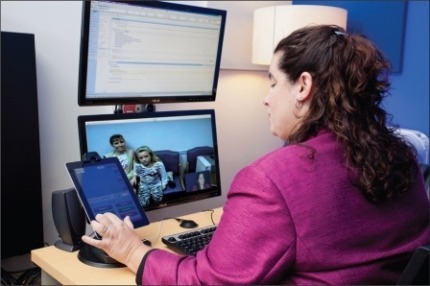Study: An innovative telehealth service to provide high quality ADHD treatment
 .
.
An unfortunate reality is that many children with ADHD do not have access to high quality, evidence-based treatment for ADHD. This is especially true in rural communities where children are generally treated by primary care providers who may have less ADHD-specific training than child psychiatrists and where high quality behavioral treatment may also be less readily available. Increasing access to excellent ADHD treatment is thus an important priority, even as efforts to develop new and potentially more effective ADHD treatments are ongoing.
The new study
A study published recently in the Journal of the American Academy of Child and Adolescent Psychiatry, Effectiveness of a telehealth service delivery model for treating Attention-Deficit/
Participants were 223 children ages 5.5 to 12 (nearly 70% boys)referred by 88 primary care providers across 7 rural communities in Washington and Oregon — all were diagnosed with the combined type of ADHD, i.e., they had both inattentive and hyperactive-impulsive symptoms. Children were randomly assigned to one of two treatment conditions — a telehealth delivery model or to augmented primary care. These treatment modalities are described below.
Telehealth delivery model — This treatment arm combined medication treatment with behavior training for parents. Both services were provided at community clinics.
Child psychiatrists were trained to deliver evidence-based medication treatment for ADHD through video conferencing. This enabled youth to receive high quality medication treatment for ADHD delivered by experienced child psychiatrists. Six teleconference sessions were conducted at community clinics with adequate video conferencing capabilities; during these sessions, parents were educated about the potential role and value of medication in treating their child. Medication treatment for each child was prescribed by the ‘telepsychiatrists’ using evidence-based algorithms developed in the Texas Children’s Medication Algorithm for Project.
Following the medication treatment conferences, families met with a master’s level community therapist who provided caregiver behavior training. Community clinicians were trained to provide the behavior management program via an online curriculum developed by the study research psychologist and through discussing training cases with the psychologist. This enabled rural clinicians to provide evidence-based behavioral parent training for ADHD to parents in their community.
The 6‑session curriculum focused on key elements of evidence-based parent training programs for elementary school children with ADHD. Parents acquired an understanding of ADHD based on current scientific knowledge, learned to provide clear instructions and to use time-out and other consequences effectively, developed praising and ignoring skills, learned to use time-out and other consequences effectively, and learned how to advocate for their child at school.
Telepsychiatry sessions and the behavior management program were spread over 22 weeks, with 3–4 weeks between sessions.
Augmented primary care — Children in the control condition were treated by their primary care provider. This was considered augmented primary care because unlike in typical practice, each primary care physician received an extensive video consultation with a child psychiatrist. The ‘telepsychiatrists’ were instructed to provide a comprehensive consultation that included medication recommendations and recommendations for mental health services and school programs when considered appropriate. Once the consultation was provided, primary care physicians conducted treatment as they saw fit. Information on the number of children in this group who received any treatments other than medication was not provided.
Outcomes measures — Caregivers and teachers completed the Vanderbilt ADHD Rating Scale at baseline and 4 subsequent times; the final time point occurred 3 weeks after the last session for the telehealth delivery group. All behavior ratings were provided via the internet. The Vanderbilt includes items that assess the DSM‑V symptoms of ADHD, oppositional-defiant behavior, and children’s academic, behavioral, and social functioning.
The results
Although children in both study arms improved over time, children in the telehealth delivery arm showed significantly greater benefits according to parents. This was evident in the following key findings:
- At baseline, approximately 83% of children in both groups were rated as showing at least 6 inattentive symptoms by their parents. At week 25, this was reported by only 23% of telehealth parents and 48% of control parents. Six or more hyperactive-impulsive symptoms were reported by roughly 60% of parents in each group; at week 25 this had dropped to 16% for telehealth parents and 31% for control parents. Greater improvements for the telehealth group were evident by week 10 for hyperactivity and by week 19 for inattention.
- Parents’ ratings also indicated that significantly greater reductions in oppositional-defiant behavior and significantly greater improvement in academic, behavioral, and social functioning. The magnitude of the differences between the treatment groups would be considered to fall in the small to moderate range.
Differences between the 2 treatment approaches were less evident in the teacher ratings, but in the direction of favoring the telehealth model.
Summary and Implications
Results from this study demonstrate the effectiveness of a telehealth service delivery model for treating ADHD in communities with limited access to specialty mental health services. Parents of children assigned to the telehealth group reported significantly greater improvement in their child’s ADHD symptoms and functioning compared to parents of children who received augmented primary care. Results based on teacher report — although not generally statistically significant — were in the same direction. Thus, this delivery model may be a cost-effective and viable way to increase the number of children with ADHD who have access to high quality, evidence-based care.
There are limitations to this study that are important to note. First, it is disappointing that results were not more robust for teachers, given the importance of improving school functioning in children with ADHD. This may reflect the fact that the control condition in this study, i.e., augmented primary care, included expert psychiatric consultation that is rarely obtained in routine primary care. Thus, the outcomes for children in the augmented primary care group may have already been better than what is typical for children treated by primary care providers alone.
It is also the case that behavioral training was provided only to parents, and the telehealth model did not include any direct training/consultation with teachers. Behavioral treatments generally yield the largest effects in the setting in which they are implemented. Thus, although the caregiver training may have had a substantial impact on children’s behavior at home, the impact on their school behavior would not be as pronounced. Thus, this intervention may have benefited by the addition of a school component in which teachers received consultation regarding classroom behavior management via teleconferencing.
Finally, the last outcome assessment occurred only 3 weeks after the telehealth intervention ended. Thus, although it would be important to know whether the more extensive treatment received by telehealth children and families resulted in sustained benefits, the current study does not allow for this. Addressing this question require more extensive follow up data than was reported, e.g., 3 months, 6 months, 1 year. Perhaps such data will be forthcoming shortly.
These limitations aside, this study provides an excellent model for how high quality, evidence-based treatment for ADHD can be provided to a greater number of children and families. Whether this service delivery model gains traction in the years ahead remains to be seen.
 – Dr. David Rabiner is a child clinical psychologist and Director of Undergraduate Studies in the Department of Psychology and Neuroscience at Duke University. He publishes the Attention Research Update and is teaching the upcoming online course How to Navigate Conventional and Complementary ADHD Treatments for Healthy Brain Development (May 2015; registration open).
– Dr. David Rabiner is a child clinical psychologist and Director of Undergraduate Studies in the Department of Psychology and Neuroscience at Duke University. He publishes the Attention Research Update and is teaching the upcoming online course How to Navigate Conventional and Complementary ADHD Treatments for Healthy Brain Development (May 2015; registration open).
Learn more:


